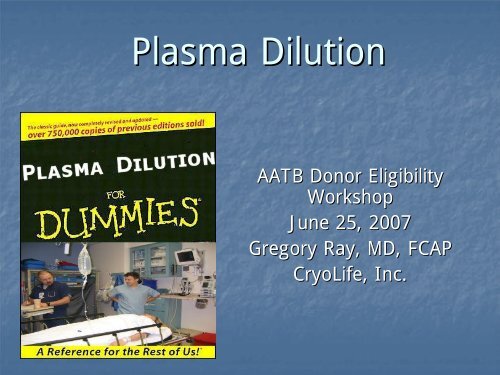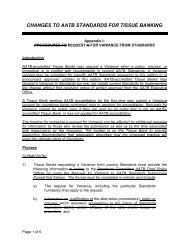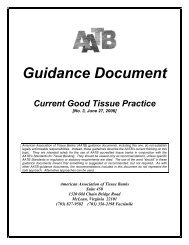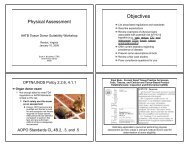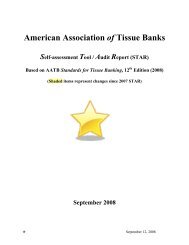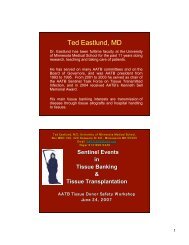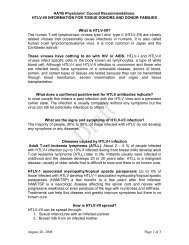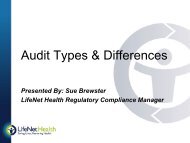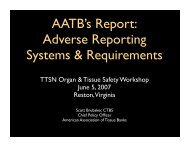Plasma Dilution
Plasma Dilution
Plasma Dilution
Create successful ePaper yourself
Turn your PDF publications into a flip-book with our unique Google optimized e-Paper software.
<strong>Plasma</strong> <strong>Dilution</strong>AATB Donor EligibilityWorkshopJune 25, 2007Gregory Ray, MD, FCAPCryoLife, Inc.
<strong>Plasma</strong> <strong>Dilution</strong>Workshop• Basic Body Fluid Physiology• What is <strong>Plasma</strong> <strong>Dilution</strong> and Why Do WeCare?• How Do We Evaluate <strong>Plasma</strong> <strong>Dilution</strong>?• Case Presentations and Discussion• Other Topics
Body Fluid DistributionTotal BodyWaterIntracellular fluid2/3RBC 1/12Extracellularfluid1/3Interstitial Fluid3/4<strong>Plasma</strong> 1/4Blood VolumeBasic Physiology
Body Fluid CompartmentsIntracellularFluid55%Transcellular2%Connective tissue/Bone15%<strong>Plasma</strong>8%InterstitialFluid 20%Basic Physiology
Blood VolumesInfantsRed Cell Vol. (ml/kg) 40<strong>Plasma</strong> Vol. (ml/kg) 47Blood Vol. (ml/kg) 87AdultsMale Female26 2440 3666 60Basic Physiology AABB Technical Manual 15 th Ed. , 2005
Basic PhysiologyBlood/Tissue Homeostasis
Fluid MovementFluid movement between compartments is driven by therelative difference between opposing forces:Blood Pressure: : Pressure produced by heart, directedOUTWARD from capillaryOsmotic Pressure: : Pressure resulting from difference inconcentration of dissolved particles (proteins, electrolytes,etc.) between fluids on opposite sides of a semi-permeablemembrane, direction can changeOncotic Pressure: : Osmotic pressure produced by proteinsBasic Physiology
Basic PhysiologyFluid Movement
Physiologic Response to Hemorrhage• Loss of blood volume produces a drop inblood pressure• Loss of RBCs and plasma protein• Increased heart rate and vasoconstriction• Initial influx of fluid into vasculature from ISF• Slow redistribution (24-48 48 hrs) of plasmaproteinsBasic Physiology
So, What is <strong>Plasma</strong> <strong>Dilution</strong> andWhy Should We Care?• <strong>Plasma</strong> Diluted Donor• August 1986, North Carolina• 30 yr old male, MVA, head/neck lacerations• Hypotensive; ; admit sample drawn for T & XM• < 1 hr after admit, transfusions started• Expedited to surgery• ≈ 11 hrs after admit, rec’d d 56 units of blood/componentsMMWR May 29, 1987; 36:306-308
So, What is <strong>Plasma</strong> <strong>Dilution</strong> andWhy Should We Care?• <strong>Plasma</strong> Diluted Donor56 ‘unit’ breakdown1 whole blood28 packed red cells7 fresh frozen plasma20 platelets• Blood drawn for serological testing after above productstransfused; HIV test negative by EIA• Brain death declared 2 days laterMMWR May 29, 1987; 36:306-308
So, What is <strong>Plasma</strong> <strong>Dilution</strong> andWhy Should We Care?• Consent obtained, family interviewed, deniedknowledge of HIV risk factors• Kidneys, heart, & liver recovered andtransported to other medical centers• One center re-tested new blood sample drawnupon recovery of the liver• HIV Ab reactive (HTLV-IIIAb), confirmed by WB• Liver, heart, and one kidney alreadytransplantedMMWR May 29, 1987; 36:306-308
So, What is <strong>Plasma</strong> <strong>Dilution</strong> andWhy Should We Care?• Admit sample from original hospital was located (inblood bank) & tested, and was reactive for HIV Ab;tested by 2 separate labs• Original post-transfusion transfusion sample re-tested x 2 labs andagain negative for HIV Ab, , as well as WB• The kidney & liver recipient both reported to haveseroconverted.....samples drawn 10 & 12 weeks posttransplant• When an organ donor is transfused, CDC suggestssearching for “admission serum” or a “pre-transfusionsample” which may be available from the blood bankMMWR May 29, 1987; 36:306-308
§ 1271.80 What are the generalrequirements for donor testing?• (d) Ineligible donors. . You must determine the followingdonors to be ineligible:• (2)(i) A donor in whom plasma dilution sufficient toaffect the results of communicable disease testing issuspected, unless:• (A) You test a specimen taken from the donor beforetransfusion or infusion and up to 7 days before recoveryof cells or tissue; or• (B) You use an appropriate algorithm designed toevaluate volumes administered in the 48 hours beforespecimen collection, and the algorithm shows thatplasma dilution sufficient to affect the results ofcommunicable disease testing has not occurred.
§ 1271.80 What are the generalrequirements for donor testing?• (ii) Clinical situations in which you must suspect plasmadilution sufficient to affect the results of communicabledisease testing include but are not limited to the following:• (A) Blood loss is known or suspected in a donor over 12years of age, and the donor has received a transfusion orinfusion of any of the following, alone or in combination:• (1) More than 2,000 milliliters (mL(mL) ) of blood (e.g., wholeblood, red blood cells) or colloids within 48 hours beforedeath or specimen collection, whichever occurred earlier, or• (2) More than 2,000 mL of crystalloids within 1 hour beforedeath or specimen collection, whichever occurred earlier.
• Blood<strong>Plasma</strong> <strong>Dilution</strong>IV Fluids• Whole Blood• Packed Red Blood Cells (PRBCs(PRBCs)• Colloids (large molecules)• Fresh Frozen <strong>Plasma</strong> (FFP), Cryoprecipitate• Albumin• Platelets• Polysaccharide solutions (Hetastarch(Hetastarch, Dextran)• Crystalloids (small molecules)• Salt solutions (Normal saline, Lactated Ringer’s)• Glucose solutions (D5W)• Total Parenteral Nutrition (TPN)
How Do You Assess <strong>Plasma</strong> <strong>Dilution</strong>?• Use a pre-transfusion/infusion sample for testingif available• If such a sample is not available, then you mustuse an algorithm to determine suitability of IDtesting sample• The algorithm compares the fluids receivedwithin the specified time frames to the donor’sblood/plasma volume• If the algorithm shows a >50% (1:2) dilution,then the sample is UNSUITABLE for ID testing
1271 Final Guidance DocumentSection IV (F)5. AlgorithmsCalculating blood and plasma volumes for donors in the 45-100kilogram range, where there is blood loss with replacement:• We recommend that you calculate and assess both blood volumeand plasma volume as follows:• You may determine the blood volume in milliliters (mL(mL) ) by dividingthe body weight in kilograms (kg) by 0.015, or alternatively bymultiplying the body weight in kilograms by 70 mL/kg.• You may determine the plasma volume in milliliters (mL(mL) ) by dividingthe body weight in kilograms (kg) by 0.025, or alternatively bymultiplying the body weight in kilograms by 40 mL/kg.
Sample <strong>Plasma</strong> <strong>Dilution</strong> AlgorithmIs a sample available that was drawnbefore transfusion/infusion?YesTest sampleNoIs Donor > 12 years old?YesDid blood loss occur?YesNoNoPerform calculationsTest sampleAre the following conditions exceeded:1. 2000 mL blood or colloid within 48 hours or2. 2000 mL crystalloids within 1 hour orNoTest sample3. 2000 mL total combination of blood and colloid in last 48hours with crystalloid in last hourYesPerform calculations1271 Final Donor Eligibility Guidance Document Appendix 1
Sample <strong>Plasma</strong> <strong>Dilution</strong> AlgorithmCalculations for a 45-100 kg donor:A = Total volume of blood transfused in the 48 hours before death or sample collection,B = Total volume of colloid infused in the 48 hours before death or sample collection,C = Total volume of crystalloid infused in the 1 hour before death or sample collection,BV = donor’s s blood volume• Calculated blood volume = donor’s s weight (kg) / 0.015 ORdonor’s s weight (kg) x 70 mL/kgPV = donor’s s plasma volume• Calculated plasma volume = donor’s s weight (kg) / 0.025 ORdonor’s s weight (kg) x 40 mL/kgCalculate both:1. Is B + C > PV? NO- Test sample Yes- Sample Unsuitable2. Is A + B + C > BV? NO- Test sample Yes- Sample Unsuitable1271 Final Donor Eligibility Guidance Document Appendix 2
Case Presentation #1• Obese 40 year old male presented to ERwith severe chest pain• Chest CT shows an aortic dissection• Taken to OR for emergent repair• Suffered anoxic brain injury• Consented for organ/tissue donation aftercardiac death (DCD)• Post-transfusion transfusion blood sample used forinfectious disease testing
Case Presentation #1Fluids Received:• 48 Hours prior to blood draw:• 11 units PRBC (4070 mL)• 4340 mL Colloid• 1 Hour prior to blood draw:• 100mL NS
Case Presentation #1• Donor Weight: 326 lbs (148 kg)• Donor Height: 5’10510” (178cm)• Estimated Blood/<strong>Plasma</strong> Volume (FDA method)• BV= 148 kg /0.015= 9,867 mL• PV= 148 kg/0.025= 5,920 mL• Blood+Colloid+Crystalloid = 8,510 mL < BV• Colloid + Crystalloid = 4,440 mL < PV• Passes- Sample Acceptable
Hemodilution CalculationProblems• A donor who is obese• A donor who weighs less than 45 kilograms ormore than 100 kilograms• Fat tissue is less vascular than muscle;therefore, less blood volume/gm of tissue mass• Does the FDA recommended formula accuratelyestimate the donor’s s blood/plasma volume?
<strong>Plasma</strong> VolumeWeight vs. Body Surface Area<strong>Plasma</strong> Volume Calculation ComparisonAdult Male 5'10"<strong>Plasma</strong> Volume (mL)900080007000600050004000300020001000030405060708090100110Weight (kg)120130140150160170180190200FDA PVBSA PV
Blood VolumeWeight vs. Body Surface AreaBlood Volume Calculation ComparisonAdult Male 5'10"14000Estimated BV (mL)12000100008000600040002000030405060708090100110Weight (kg)120130140150160170180190200FDA-BVBSA-BV
Case Presentation #1Alternate Calculations• Donor Weight: 326 lbs (148 kg)• Donor Height: 5’10510” (178cm)• Estimated Blood/<strong>Plasma</strong> Volume (BSA method)• BV=(3.29xBSA (m2)-1.229 x 1000)= 7,233 mL• PV= BSA(m2) x 1560= 4,012 mL• Blood+Colloid+Crystalloid = 8,510 mL > BV• Colloid + Crystalloid = 4,440 mL >PV• Fails- Sample NOT AcceptableHurley PJ. J Nuclear Med. 1975; 16:46-52Recommended Methods for Measurement of Red-Cell and <strong>Plasma</strong> Volume. J Nucl Med. 1980; 21:793-800Baker RT, Kozoll DD, et al. Surg Gynecol Obstet. 1957; 104: 183-189.
Case Presentation #1Discussion• FDA specifically states that calculations providedin the DE Guidance Document are for donorsweighing 45-100kg• The FDA calculations provide a good estimate ofblood/plasma volume for an average sized adult,but are inaccurate for children and obese adults• Other more physiologically appropriatecalculations should be used in these populations• What about males vs. females in the 45-100kgweight range?
Case Presentation #2• 24 year old male involved in MVA• Severe head injury, liver laceration, open tibialfracture• EMS report states 1 18g IV 1L NS in LAC at 21:00hours• Patient arrives in ER within 15 mins• At 21:16 2 nd Liter NS started in LAC• At 21:19 18g central line, R Fem, with 1L LRunder pressure infusion
Case Presentation #2• Patient has BP 60/30 with HR 30• At 21:26 Patient goes into V-fib V• ACLS protocol initiated• At 21:33 3 rd Liter of NS is started in LAC• Code is unsuccessful and donor ispronounced dead at 21:36• No pre-infusion blood sample was drawn
Case Presentation #2• Weight 178 lbs (81kg)• BV= 81 x 70 ml/kg = 5670 ml• PV= 81 x 40 ml/kg = 3240 ml• Fluids:• EMS- 1000ml NS LAC• ER- 21:16 1000ml NS LAC21:18 1000ml LR RF21:33 1000ml NS LAC• Code ended/Pronounced dead at 21:36
Case Presentation #2Discussion• The last liter of NS was hung 3 mins beforedeath; do you count the entire liter?• Is it possible for a liter of NS to be given in3 mins?• Can you estimate worst case amount basedon size of catheter?
Hodge D. Am J Emer Med. 1985;3:403-407Case Presentation #2
Hodge D. Am J Emer Med. 1985;3:403-407Case Presentation #2
Case Presentation #3• 7 year old male MVA victim with massive headinjuries, femoral fracture, found in a large poolof blood• EMS: 20g IV NS in RAC (75ml per EMT)• ER: 22:36 500ml NS22:40 Blood Draw22:41 1 unit PRBCsAdditional 300 PRBC, 475 FFP, 80 cryo,526 albumin given prior to death
Case Presentation #3<strong>Plasma</strong> <strong>Dilution</strong> WorksheetBlood Draw @ 2240A. Total Blood = 0 mlB. Total Colloid = 0 mlC. Total Crystalloid = 575 mlPV= 1164 ml BV= 1939 mlB+C= 575
Case Presentation #3CBC Results22:40 22:55WBC (K/uLuL) ) 1.8 10.0RBC (M/uLuL) ) 1.00 3.84Hgb (g/dL)) 2.9 10.8Hct 8.3% 33.1%Plt (K/uLuL) ) 71 121
Case Presentation #3Discussion• Laboratory values may indicate problemswith sample• Be aware of blood draws obtaineddownstream from IV sites• Blood loss may so massive that even fluidvolumes less than those calculated mayproduce significant dilution
Other Topics• What to do when exact fluid volumes arenot given in medical record?• Standardized blood product volumes• Seek actual transfusion records• Look for orders or other data that indicatesrate of administration, IVs often on controlledrate pump• Estimate max rates based on catheter size


